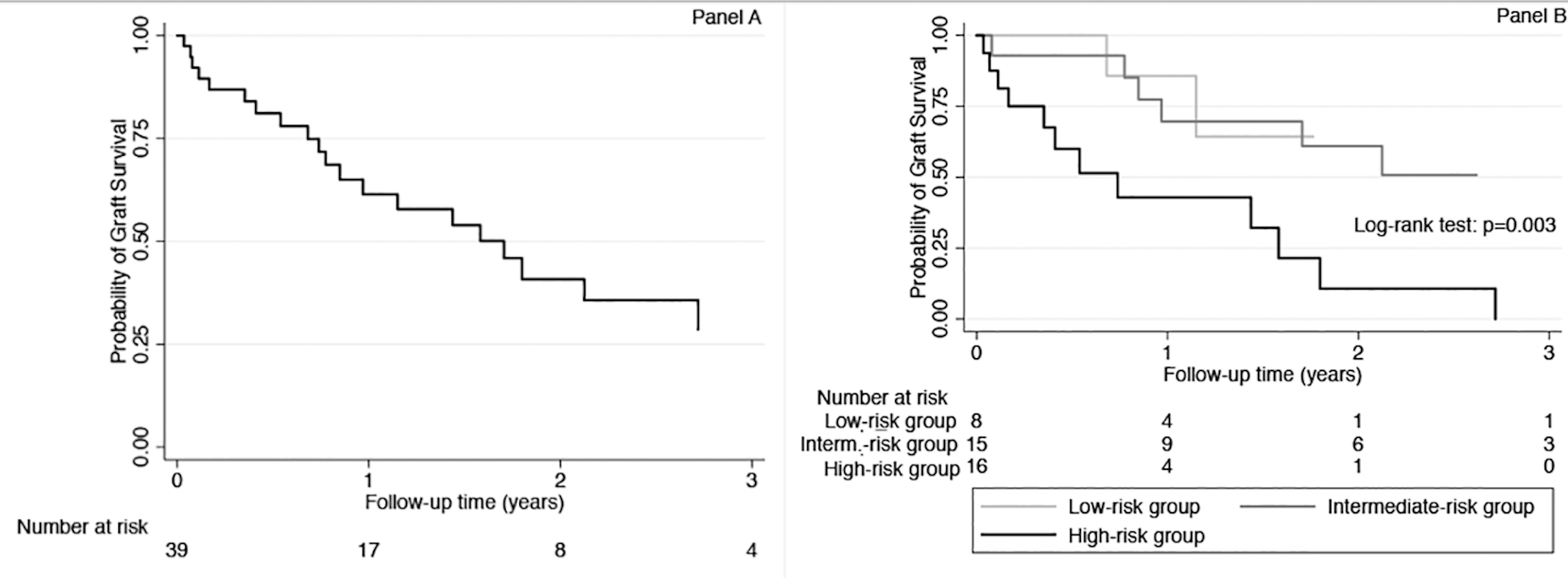Validation of Prognostic Index for Allograft Outcome in Kidney Transplant Recipients with Transplant Glomerulopathy
1James D. Eason Transplant Institute, Methodist University Hospital, Memphis, TN, 2Department of Transplantation and Surgery, Semmelweis University, Budapest, Hungary, 3Faith & Health Division, Methodist Le Bonheur Healthcare, Memphis, TN, 4Arkanalabs, Little Rock, AR
Meeting: 2020 American Transplant Congress
Abstract number: B-064
Keywords: Biopsy, Graft survival, Kidney transplantation, Rejection
Session Information
Session Name: Poster Session B: Kidney Chronic Antibody Mediated Rejection
Session Type: Poster Session
Date: Saturday, May 30, 2020
Session Time: 3:15pm-4:00pm
 Presentation Time: 3:30pm-4:00pm
Presentation Time: 3:30pm-4:00pm
Location: Virtual
*Purpose: Kidney transplant recipients with Transplant Glomerulopathy (TG) have very poor allograft survival compared to those without TG. The objective of this research was to externally validate a previously developed TG prognostic score in a US kidney transplant population with a high proportion of African Americans.
*Methods: Relevant data of 39 recipients with TG was collected. The primary outcome of interest was graft loss within 3 years following the diagnosis of TG. Associations between the TG prognostic score and allograft graft loss were examined in survival models. Harrel’s c-index was applied to assess discrimination and Grønnesby-Borgan test was used for calibration assessment.
*Results: The mean±SD age of the cohort at the time of diagnosis of TG was 40±17 years, 64% were male, 33% and 61% of patients were white and African- American, respectively. The lowest number of graft losses (n=2; 25%) occurred (crude incidence rate, 130 per 1000 patient-years; 95% confidence interval [CI]: 33-522) in the low-risk group; a total of 8 (53%) graft losses occurred (crude incidence rate, 258 per 1000 patient-years; 95% confidence interval [CI]: 129-517) in the intermediate-risk group and the highest number of graft losses (n=12, 75%) occurred (crude incidence rate, 1,019 per 1000 patient-years; 95% confidence interval [CI]: 579-1,794) in the high-risk group (p=0.003) (Figure: panel A: entire group, panel B: by risk group).
Compared to patients with a low-risk TG score, patients with an intermediate-risk TG score had a similar risk of graft loss over time [Hazard Ratio (HR) (95% CI): 1.80 (0.37-8.64)], while recipients with a high-risk TG score had a significantly higher risk of graft loss [HR (95% CI): 6.59 (1.38-31.41)] using Cox proportional risk regression model. The Harrel’s c-index, was 0.69, which indicates good discrimination of the model. Additionally, the p-value of the likelihood-ratio statistic of the added variable version of the Grønnesby-Borgan test was 0.51, suggesting good calibration of the model.
*Conclusions: The TG prognostic score had good discrimination and calibration statistics and can be used to predict allograft outcome in African-American kidney transplant recipients in the US.
To cite this abstract in AMA style:
Talwar M, Balaraman V, Bhalla A, Cseprekal O, Yazawa M, Podila PS, Azhar A, Cossey LN, Eason JD, Molnar MZ. Validation of Prognostic Index for Allograft Outcome in Kidney Transplant Recipients with Transplant Glomerulopathy [abstract]. Am J Transplant. 2020; 20 (suppl 3). https://atcmeetingabstracts.com/abstract/validation-of-prognostic-index-for-allograft-outcome-in-kidney-transplant-recipients-with-transplant-glomerulopathy/. Accessed November 25, 2025.« Back to 2020 American Transplant Congress

